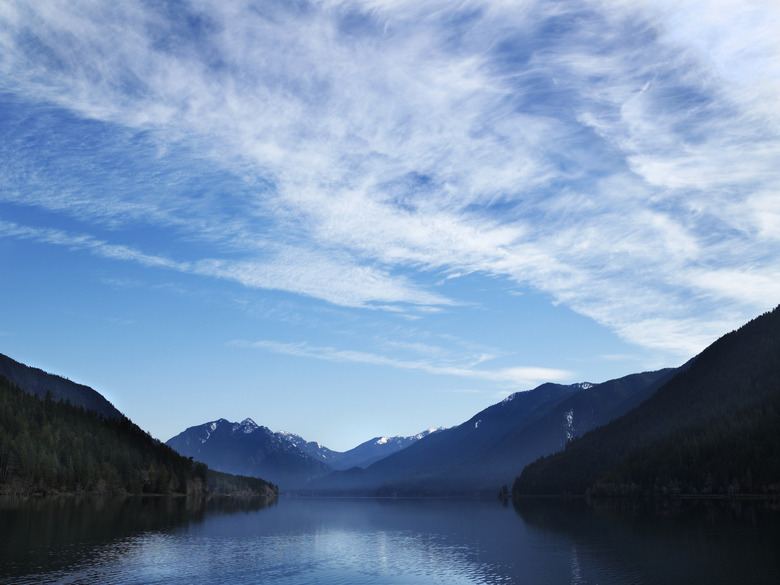What Happens To The Temperature As Altitude Increases?
There's a scientific reason why it's smart to pack that extra sweater when you're headed to the mountains. Temperatures drop steadily as altitude increases, at least in the first layer of atmosphere known as the troposphere.
Temperature readings in the atmosphere's other three layers, which are beyond the reach of any mountain peak, also change with increasing altitude, but they change at significantly different rates, and they don't always decrease.
Altitude Definition (Geography)
Altitude Definition (Geography)
The altitude definition (geography) refers to the heigh of an object or area above sea and/or ground level. It refers to the vertical elevation. When talking about the various layers of the atmosphere, we often speak in terms of the altitude definition, geography, and how high up the layer goes in relation to sea/ground level.
You'll also see "altitude" and "elevation" used somewhat interchangeably: increasing altitude is the same as increasing elevation.
The Troposphere: The Weather Layer
The Troposphere: The Weather Layer
Humans are most affected by changes in the troposphere. Of the four main atmospheric layers, the troposphere is closest to Earth. It extends approximately 12 km, or 7 miles, upward and is where all weather activity occurs. Because heat from the sun is retained in the ground, the air is warmest there, and it becomes gradually colder as you move upward.
This is the layer where you will notice temperature change with elevation. In the troposphere, temperatures decrease by an average of 6.5 degrees Celsius per every rise of one thousand meters, which works out to about 3.5 degrees Fahrenheit per thousand feet.
The Stratosphere and the Ozone Layer
The Stratosphere and the Ozone Layer
Temperature change with elevation is mostly felt by us in the troposphere, but it continues as you move into other atmospheric laters. Airplanes often fly in the stratosphere, which begins about 10 to 13 kilometers (33,000 to 43,00 feet) above the ground, to avoid the turbulent weather patterns in the troposphere. Temperature in the stratosphere layer increases with altitude, which is a phenomenon known as thermal inversion.
There are two reasons for the inversion. First, the stratosphere has two layers, or strata: a colder, denser one on the bottom and a layer of warmer, lighter air on top.
Second, an ozone layer in the upper stratosphere readily absorbs ultraviolet light from the sun. As this radiation increases molecular activity, molecular vibrations produce a spike in temperature.
The Mesosphere: Thinning Air
The Mesosphere: Thinning Air
The pattern reverses yet again in the mesosphere. Temperatures decrease with increasing height as the ozone layer is left behind and the air thins out with increasing altitude. The lowest portion of the low-pressure mesosphere is heated by the warm air of the upper stratosphere.
This heat radiates upward, getting less intense as altitude increases.
Over a distance of about 40 kilometers (25 miles), the mesospheric temperature decreases from an average of 0 degrees Celsius (32 degrees Fahrenheit ) to minus 90 degrees Celsius (minus 130 degrees Fahrenheit).
Thermosphere: Earth's Upper Atmosphere
Thermosphere: Earth's Upper Atmosphere
It is hard to fathom the extremes of cold and heat that exist in the thermosphere. Temperatures in the 40-kilometer (25-mile) top atmospheric layer easily swing by hundreds of degrees in each direction, from minus 90 degrees to more than 1,500 degrees Celsius (minus 130 degrees to 2,700 degrees Fahrenheit).
Oxygen molecules in the thermosphere absorb solar heat as they do in the stratosphere, but are much more affected by solar activity. Because few molecules are present in the thin air of the thermosphere, the existing molecules have much more room to move and can gain significantly more kinetic energy. They are so far apart, though, that temperature doesn't have the same meaning as in lower parts of the atmosphere.
Cite This Article
MLA
Rose, Sierra. "What Happens To The Temperature As Altitude Increases?" sciencing.com, https://www.sciencing.com/info-8179549-happens-temperature-altitude-increases/. 31 May 2019.
APA
Rose, Sierra. (2019, May 31). What Happens To The Temperature As Altitude Increases?. sciencing.com. Retrieved from https://www.sciencing.com/info-8179549-happens-temperature-altitude-increases/
Chicago
Rose, Sierra. What Happens To The Temperature As Altitude Increases? last modified March 24, 2022. https://www.sciencing.com/info-8179549-happens-temperature-altitude-increases/
